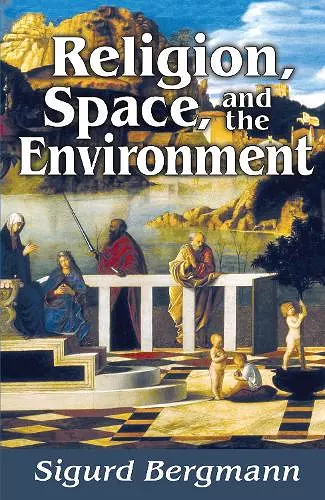Religion, Space, and the Environment
Format:Hardback
Publisher:Taylor & Francis Inc
Published:30th Apr '14
Currently unavailable, and unfortunately no date known when it will be back

Religions often nurture important skills that help believers locate themselves in the world. Religious perceptions, practices, emotions, and beliefs are closely interwoven with the environments from which they emerge. Sigurd Bergmann's driving emphasis here is to explore religion not in relation to, but as a part of the spatiality and movement within the environment from which it arises and is nurtured.
Religion, Space, and the Environment emerges from the author's experiences in different places and continents over the past decade. At the book's heart lie the questions of how space, place, and religion amalgamate and how lived space and lived religion influence each other.
Bergmann explores how religion and the memory of our past impact our lives in urban spaces; how the sacred geographies in Mayan and northeast Asian lands compare to modern eco-spirituality; and how human images and practices of moving in, with, and through the land are interwoven with the processes of colonization and sacralising, and the practices of power and visions of the sacred, among other topics.
"Bergmann challenges scholars to rethink the concept and meaning of space, especially in the relation to religion. In that context the attention to art makes a particular significance in the culture in which visuality is the instrument of transferring knowledge, meaning and experience."
—Marina Vicelja-Matijaši, IKON
"The sheer breadth of ideas and analysis in Religion, Space, and the Environment deserves to add Bergmann to the trinity of frequently-cited authors in the field of how we think about places."
—Bob Trubshaw, Time and Mind
"An impressive and inspiring combination of scientific rigor, following the ethical demand, reflecting on the “spiritual dignity of life” (p 282) and looking for political engagement following from these for Christians and for the Christian church. Bergmann’s intense and engaged reflection does not fear coming to normative options and critical questions, his scientific analyses finally develop their arguments in service not of abstract objectives, however in service of humanization - and they do not forget about power, injustice, suffering."
—Hans-Günter Heimbrock, International Journal of Practical Theology
"More than 200 illustrations enrich the book and make it a pleasure not only to read but also to reflect on images of sacred places and iconic meanings of landscape worldwide. The combination of text and images offers a deep insight and emotional analysis into humans' religious appropriation of landscape and environment . . . engaging and impressive . . . The comparisons of different world religions and their specific relationship with nature is the great achievement of this book. . . . [It] stimulates the reader and sometimes offers disturbing answers to the big question regarding how we should organize our future relationship towards nature in times of dangerous environmental change."
—Urte Undine Frömming, Anthropos
"[One can] take it as a sign for religion and ecology existing in one transdisciplinary field where a manifold of disciplines and perspectives enrich each other, which at present emerges under the umbrella of the "Environmental Humanities" or "Humanities and Climate Change." In this field, Religion, Space & the Environment offers a very important contribution to the discussion."
—Svensk Teologisk Kvartalskrift, Swedish Theological Quarterly
"Bergmann, who works in Norway, is one of the leading scholars of our time on studies of religion and the environment. . . . The collection of articles Religion, Space, and the Environment offers an excellent cross-section of Bergmann's versatile research themes. . . . Bergmann's strengths are his scope, creativity, and clarity of thought. . . . [H]e formulates a clear position in ecotheology. Arts provide an important role in Bergmann's thinking and his reflection deepens the text colorfully. The book contains more than 150 black and white pictures, ranging from visual arts, landscape photography to architecture and film."
—Panu Pihkala, Religionsforskaren (Scholar of Religion)
“[T]he book provides a novel approach to ecotheology, offering new impulses to the concept of memorial culture. There is a general lack of awareness of the place and space inhabited by cultural memory; a space that deeply affects the individual, regardless of whether he or she has actively created this space, or has simply claimed an already existing natural environment as his or her own. . . . The book contains a wealth of illustrations (153) . . . [that] aid in conveying the book’s central message: to visualise the impact that space has on our world, our society, and on the individual. . . . With this book, Bergmann has unearthed an important new dimension of ecotheology.”
—Theo Sundermeier, Theologische Literaturzeitung
ISBN: 9781412852579
Dimensions: unknown
Weight: 816g
500 pages